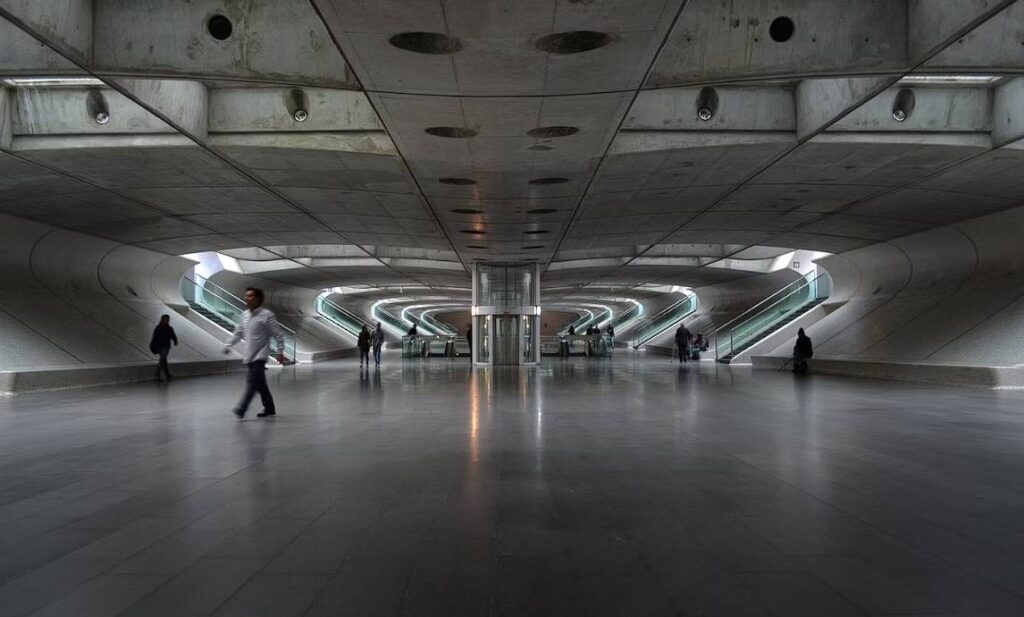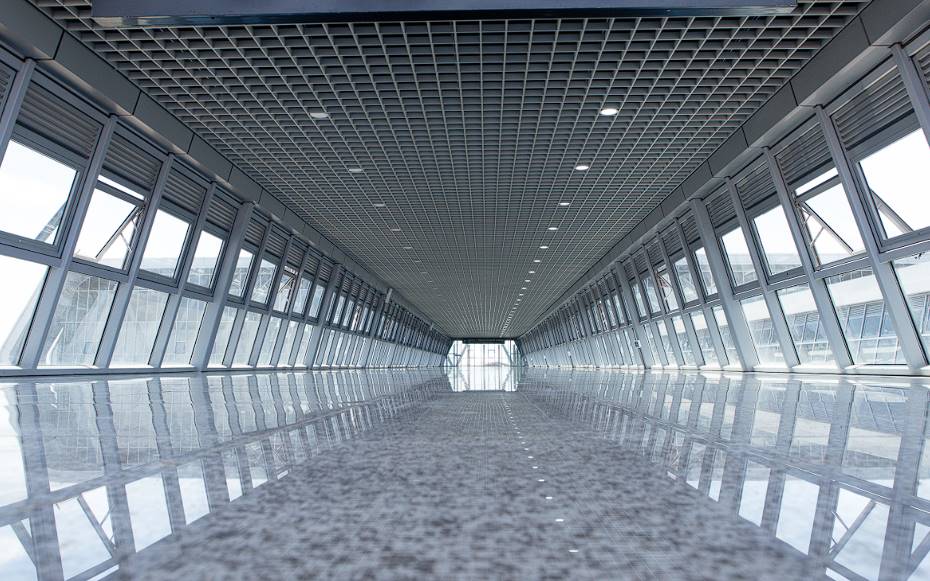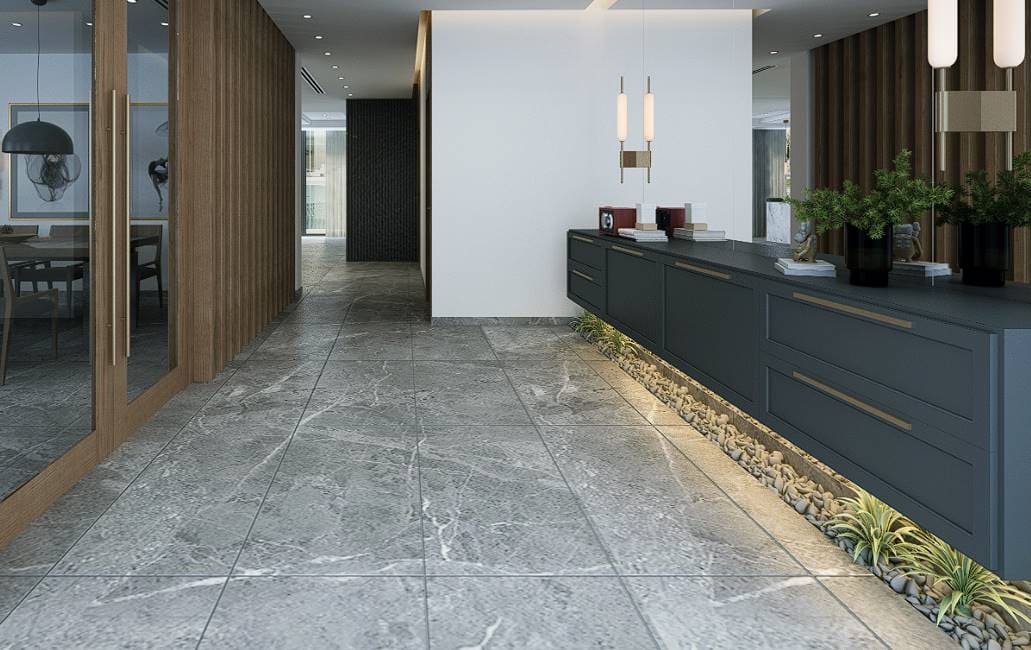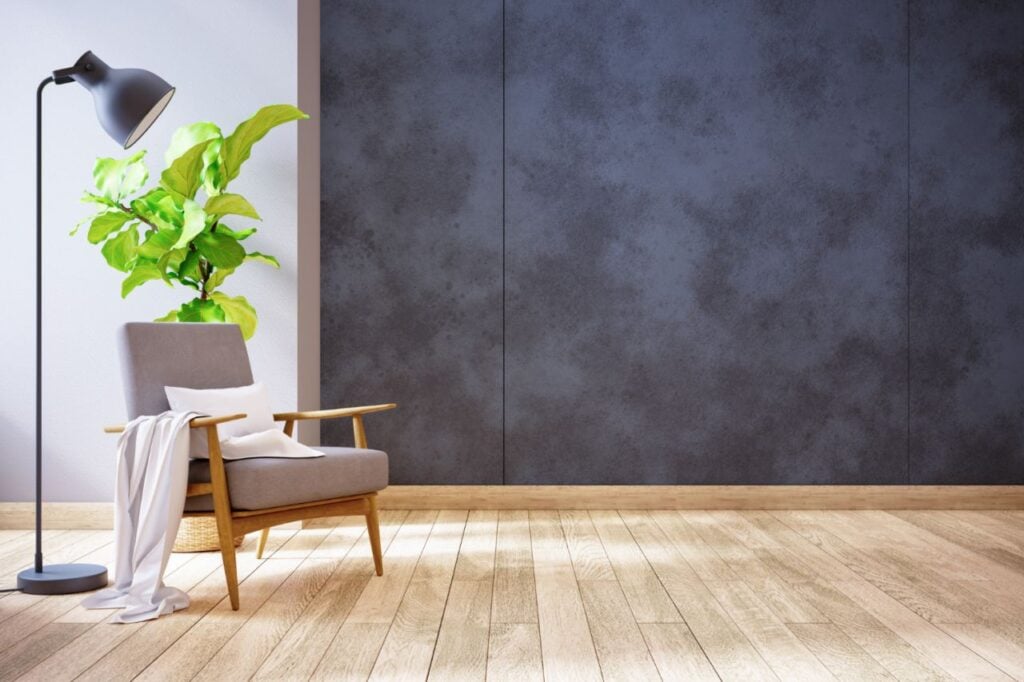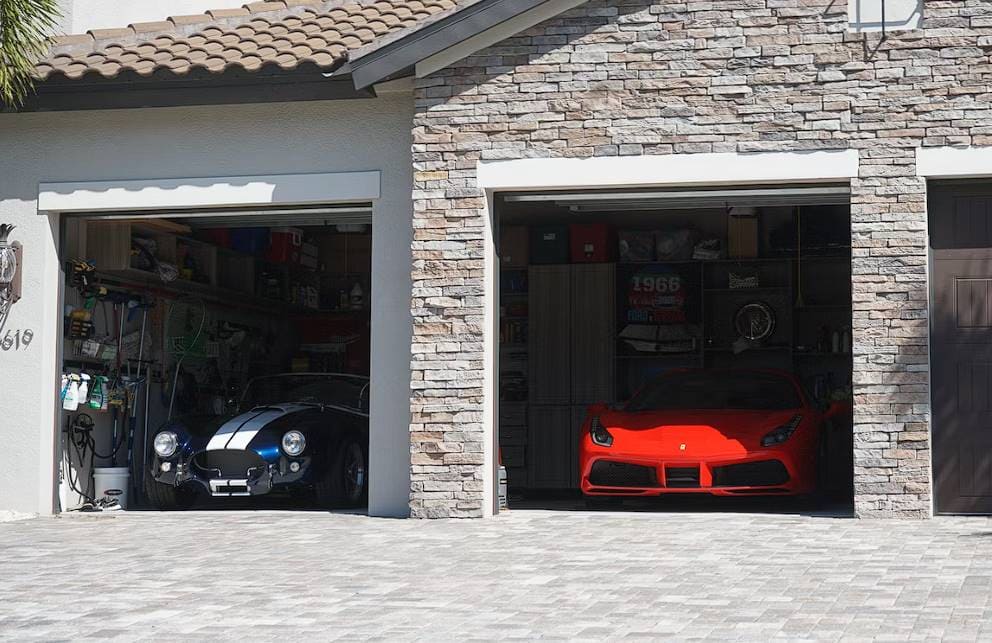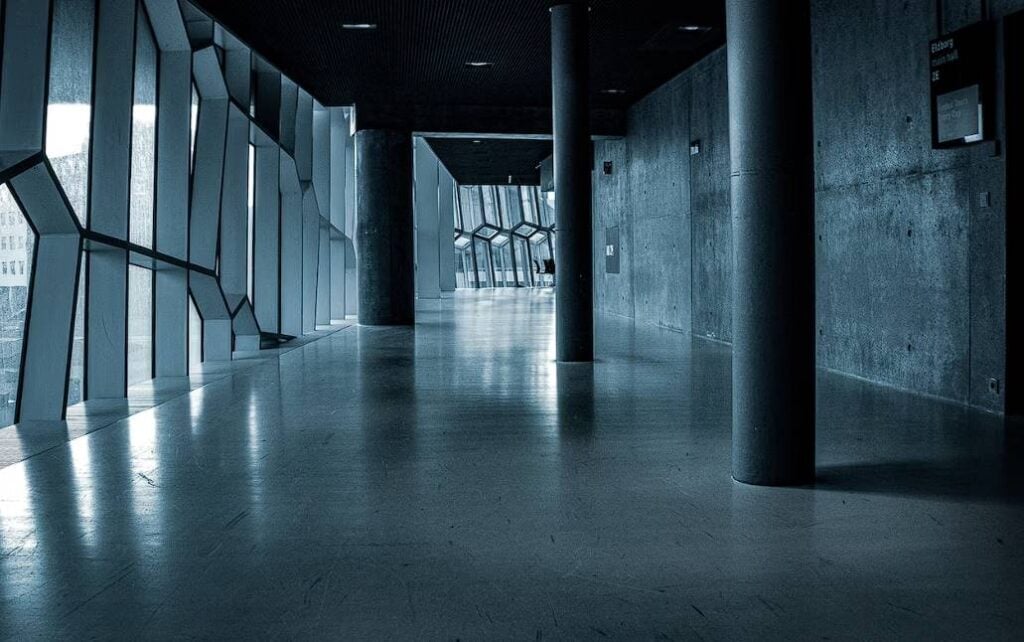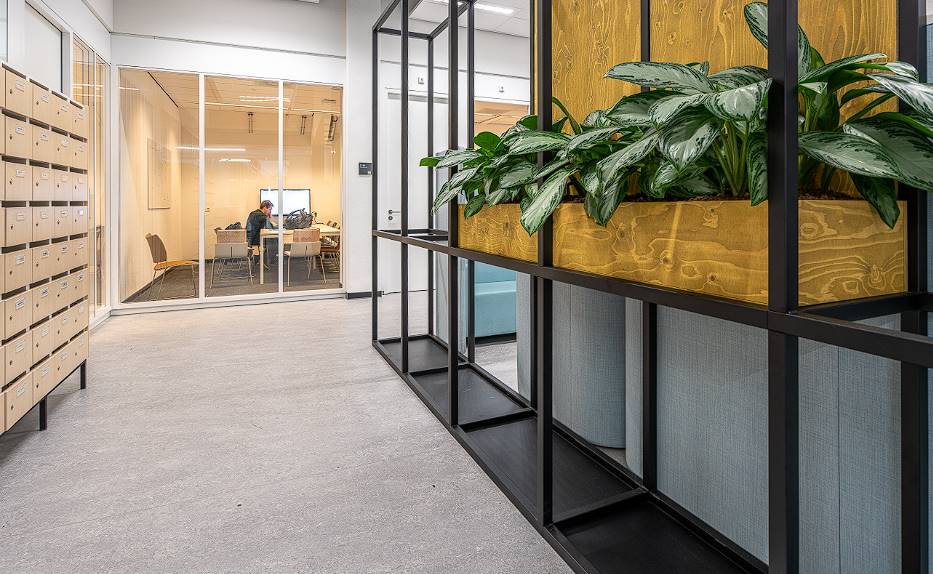Are you looking to enhance the appearance of a concrete floor in a high-traffic area such as a showroom, central lobby, or big box store? Then, polished concrete is the ideal flooring choice for you. It is a wax-free solution that can transform concrete surfaces, whether new or old, into a stunning high-gloss finish. In addition, concrete's exceptional durability and performance make it a popular option among retail, commercial, and residential spaces.
Concrete polishing is particularly effective in areas with heavy foot traffic and the need to withstand the movement of heavy objects. This technique can give a standard concrete floor a glossy and attractive look.
While some homeowners may attempt to polish their floors, relying on professional contractors with the specialized tools and expertise required to achieve the desired results is generally recommended.
What Is a Polished Concrete Floor?
Concrete is a composite material composed of different elements. It consists of an aggregate, which can be materials like sand, crushed stone, or gravel, and a binding material like cement and water. This combination gives concrete its versatile, strong, and cost-effective properties.
Creating a polished concrete floor involves pouring a concrete slab onto the ground and then polishing it to achieve a smooth and glossy surface. A protective finish is also applied to enhance its durability and appearance.
Polishing dry concrete floors gained popularity in the 1990s when Tunisian workers misinterpreted their instructions and accidentally polished a hardened surface. The unintentional result was so visually appealing that it sparked a trend of dry concrete polishing worldwide.
Where to Use Concrete
Concrete is highly suitable for various construction and flooring projects due to its strength and durability. It is a fundamental flooring material and can be utilized as the primary floor surface in structures where factors such as longevity, easy maintenance, and aesthetic appeal are significant considerations.
It finds applications in various settings, including warehouses, factories, garages, lobbies, patios, basements, and public institutions. Additionally, concrete can serve as a solid base for installing other types of flooring materials, depending on the specific requirements and purpose of the building.
Technology advancements have opened up many design options, enabling flooring professionals to transform this foundational building material. Nowadays, concrete floors can be meticulously polished to achieve a smooth surface or textured to add a distinct character. In addition, they can be enhanced with techniques like painting or staining, allowing the replication of natural materials or incorporating intricate printed designs.
In summary, concrete offers versatility and adaptability, providing durable and visually appealing flooring solutions that cater to the needs of various spaces.
How Polished Concrete Became Interior Design's Coolest Surface
Historically, concrete was not commonly chosen for residential or commercial flooring, primarily associated with practical purposes such as outdoor spaces and industrial settings. Its reputation as a practical but unrefined surface limited its use in more aesthetically-focused environments.
However, the emergence of the industrial chic design style has transformed perceptions of concrete over the years. This design trend, characterized by a fusion of rugged and sleek elements, has gained popularity and continues to be embraced by many. Concrete's practicality and visual appeal have captivated people, exuding a unique and contemporary charm.
Moreover, the increasing awareness of environmental sustainability has contributed to the growing interest in natural composite materials like concrete. Concrete is considered more ecologically sustainable than alternative flooring options, making it a favourable choice for those concerned about environmental impact.
As a result, the utilization of concrete in residential and commercial settings has expanded significantly. Its versatility, durability, and inherent beauty have captured the attention of designers and homeowners alike, leading to a continued appreciation for its practical and aesthetic qualities.
Understanding Concrete Polishing Grits
When polishing concrete is undertaken, the grits used serve as a measure of smoothness and light reflection. The term "grits" refers to the different levels of abrasiveness in the polishing process. Lower grits result in a softer and less reflective appearance on the polished concrete floor. On the other hand, higher grits contribute to a smoother surface and increased light reflection, resulting in a more glossy finish.
Typically, the range of finish grits used in concrete polishing falls between 100 and 3000 grits. As the grit number increases, polish and shine also increase. Therefore, higher grit numbers, such as 3000, produce a higher gloss and enhance the reflective qualities of the polished concrete floor. The selection of grits depends on the desired aesthetic outcome and glossiness desired for the specific project.
Level 1 - 100-200 Grit
Achieving a level 1 ground polish typically involves stopping polishing before reaching the 100-grit resin bond. When looking down directly at the floor at this stage, it will have a somewhat hazy appearance with minimal clarity or reflection. The surface will need a higher level of gloss and shine, and the focus is primarily on levelling the floor rather than achieving a polished and reflective finish. This level of polish is often preferred for industrial or utilitarian settings where aesthetics are not the primary concern.
Level 2 - 400 Grit
This stage marks the beginning of the glossing process for the floor. At this point, the surface should be free from any visible imperfections and exhibit a smooth and consistent sheen throughout. This finish is particularly suitable for warehouse environments, balancing aesthetics and long-term durability. Compared to a high-sheen finish, the gloss achieved at this stage tends to be more resistant to wear and foot traffic, maintaining its appearance for longer. In addition, it offers a visually pleasing result while prioritizing the practical considerations of a warehouse setting.
Level 3 - 800 Grit
The process involves using a diamond abrasive of 800-grit or higher to achieve this level of polish. The result is a significantly higher sheen than a level 2 finish, with noticeable light reflectivity. When viewing the floor from 30 to 50 feet, you will observe clear reflections of side and overhead lighting on the surface. In addition, this level of polish enhances the aesthetic appeal of the floor, creating a visually striking and reflective appearance that adds a sense of sophistication to the space.
Level 4 - 1500-3000 Grit
These highly reflective and clear floors are commonly employed in retail and office projects. Their high gloss finish not only enhances the aesthetic appeal but also offers the advantage of easy cleaning. This makes them an excellent choice for high-traffic environments where durability and maintenance are important considerations. However, owners must have a maintenance plan in place to ensure the long-term upkeep of the floor's appearance. Heavy foot traffic in busy areas without proper maintenance may result in visible traffic patterns or wear on the surface. The floor's pristine look can be preserved by implementing a maintenance strategy, maintaining its attractiveness and performance over time.
Benefits of Polished Concrete Flooring
Homeowners, retailers, big-box stores, educational institutions, and medical facilities increasingly opt for polished concrete as their preferred flooring option due to its numerous advantages compared to other floor coverings. Polished concrete floors provide excellent value and stand out aesthetically, making them a compelling choice. In addition, the combination of durability, cost-effectiveness, and appealing design makes polished concrete the logical and competitive flooring solution for many applications.
Eliminating Dusting and Efflorescence
While untreated concrete possesses inherent strength, it is susceptible to specific forms of damage and natural chemical reactions. For example, one of the ongoing concerns with concrete is its porosity, which allows for salt migration (efflorescence). This process can result in dusting, potentially harming surface coatings such as epoxies. However, by opting for concrete polishing, these issues can be effectively addressed at their root, mitigating the risks associated with dusting and preserving the integrity of the surface coatings.
Affordable
Although polished concrete may have a sophisticated and upscale look, the truth is that it is a cost-effective flooring option compared to many others. It has a similar initial cost per square foot as inexpensive alternatives like carpet, and its overall lifecycle cost is lower than that of other commonly used flooring types. This affordability is particularly notable if you already have a concrete slab that can be professionally polished, as it eliminates the need for additional materials or extensive preparation.
Stain-Resistant Floor
The porosity of concrete poses a significant challenge and contributes to a significant portion of its ongoing maintenance costs over its lifetime. However, by polishing the concrete, the surface is effectively sealed and becomes denser. This enhanced density allows the polished concrete to naturally resist water, oil, and other surface contaminants, even without additional protective measures. As a result, the polished surface becomes more resistant to staining and easier to clean and maintain.
Durable
Polished concrete is renowned for its exceptional durability, particularly in manufacturing and warehousing facilities. The solid composition of polished concrete enables it to withstand heavy foot traffic and even the movement of heavy equipment without succumbing to damage. As a result, polished concrete floors are highly resistant to chipping, scratching, and other forms of wear and tear. Furthermore, when the polished surface is properly sealed, it gains resistance to chemicals such as alkalis and acids, which helps prevent corrosion and maintain the integrity of the flooring.
Brighter and Reflective
Enhanced reflectivity provided by polished concrete floors not only improves the effectiveness of safety painting but also offers long-term advantages in terms of energy control. The increased reflectivity of polished concrete contributes to superior ambient lighting, giving your facility a fresher and cleaner appearance. This enhanced lighting makes the space more visually appealing and creates a more inviting and pleasant environment for visitors and workers alike. Additionally, the improved lighting can help reduce energy consumption, leading to long-term benefits in energy efficiency.
Environmentally Friendly
Polished concrete floors are considered eco-friendly due to several reasons. Firstly, their installation and upkeep do not require hazardous chemical coatings, cleaners, or adhesives, reducing the release of harmful substances into the environment. In addition, this makes them a sustainable choice for indoor air quality.
Additionally, polished concrete floors are energy-efficient. The reflective properties of polished concrete enhance natural lighting, reducing the need for artificial lighting and lowering energy consumption. This energy efficiency contributes to a greener and more sustainable environment.
Overall, the absence of hazardous chemicals and the energy-saving characteristics of polished concrete floors make them an environmentally friendly flooring option.
Low-Cost Upkeep
Polishing your concrete floor has a significant cost-saving impact over an extended period. The dense and compact surface of polished concrete eliminates the need for aggressive scrubbing to remove stains, reducing maintenance expenses. Moreover, the characteristic sheen of the floor can be maintained without the requirement of waxing or stripping, saving you the investment and effort associated with these traditional maintenance methods. Choosing to polish your concrete floor results in substantial long-term cost savings.
Healthy
Polished concrete, being sealed and nonporous, remains dry and prevents the accumulation of allergens, dirt, and bacteria on its surface. Unlike hardwood and carpeting, polished concrete contains no harmful volatile organic compounds (VOCs), contributing to better air quality. In addition, its smooth and nonporous nature eliminates crevices where pollutants can gather, making polished concrete a favourable choice for improved indoor air quality.
Enhancing Old Floors
Treating your concrete floor, whether through epoxy flooring or concrete polishing, is a beneficial way to prolong the lifespan of the underlying slab. Polished concrete, in particular, offers exceptional compressive strength and effectively resists erosion from various factors. In addition, through a mechanical polishing process, the top layer of the concrete can be ground down to rejuvenate its appearance and integrity, contributing to an extended service life of the slab.
Customizable
While you might have a preconceived notion of how polished concrete floors appear, the possibilities for their final aesthetic are limitless. The appearance of a polished concrete floor can be customized to suit individual preferences and design preferences. For example, you can choose from a range of shine levels and have the option to select different aggregates, colours, and patterns. Additionally, you can add a personal touch to the floor by incorporating decorative engravings or graphics, allowing for a truly unique and personalized result.
Minimal Operations Disruption
Each floor coating and treatment process comes with its specific set of requirements. For instance, certain paints may require a primer layer and a designated curing period. In contrast, the time required to polish concrete can vary, but with dry mechanical polishing, a concrete floor can be ready for use immediately after completion. This eliminates the need for additional curing time, allowing for a more efficient and convenient turnaround.
No Toxins, Cleanup, or Risks
Many businesses delay extensive flooring projects due to concerns about safety hazards. However, concrete polishing offers a solution that minimizes these risks. Unlike other flooring treatments, concrete polishing does not involve harsh or abrasive chemicals, and it does not produce dangerous waste products. Additionally, the ventilation requirements for the treated area are less demanding. As a result, most concrete polishing projects can be completed within a relatively short timeframe, typically taking only a few hours or days. This allows businesses to improve their floors efficiently without compromising safety or causing significant disruptions to their operations.
When Polished Concrete Isn't Your Best Option
Polished concrete is a highly suitable choice for the majority of flooring projects. The only reason to consider an alternative flooring type is if your facility has exceptionally specific and unique requirements. We have already discussed such scenarios, which typically require a high-performance surface. If you require epoxy flooring or industrial coating, it is important to note that these surfaces may incur higher maintenance costs as they tend to deteriorate over time. While epoxy has gained popularity in residential applications, it is primarily utilized in commercial facilities, including:
- Aeroplane hangers
- Places where cars are made
- Kitchens for businesses
- Decks and front steps
- Garages
- Places like laboratories and drug stores
Some people find concrete floors uncomfortable in their homes because they have less cushion than other traditional flooring types when standing for long periods. Since concrete doesn't absorb sound as well as other materials, people living in homes with concrete floors often add rugs, curtains, and even wall panels to reduce noise.
With a big investment at stake and many things to think about, hiring an experienced concrete contractor is important to help you choose the right flooring for your space.
Conclusion
Concrete polishing is a wax-free solution that can transform concrete surfaces into a stunning high-gloss finish. It is particularly effective in areas with heavy foot traffic and the need to withstand the movement of heavy objects. Concrete is a composite material composed of an aggregate and a binding material like cement and water. It is suitable for various construction and flooring projects due to its strength and durability. Technology advancements have opened up many design options, enabling flooring professionals to transform concrete floors.
Concrete has become increasingly popular for residential and commercial flooring due to its versatility, durability, and inherent beauty. It is considered more ecologically sustainable than alternative flooring options, making it a favourable choice for those concerned about environmental impact. Polishing concrete involves using different levels of abrasiveness to achieve a smoother surface and increased light reflection. The range of finish grits used in concrete polishing falls between 100 and 3000 grits, with higher grits producing a higher gloss and enhance the reflective qualities of the polished concrete floor. Polished concrete flooring is a popular flooring option for many applications due to its durability, cost-effectiveness, and appealing design.
It is particularly suitable for industrial or utilitarian settings where aesthetics are not the primary concern. Level 2 - 400 Grit is the beginning of the glossing process and offers a smooth and consistent sheen. Level 3 - 800 Grit is achieved using a diamond abrasive of 800-grit or higher and has noticeable light reflectivity. Level 4 - 1500-3000 Grit is used in retail and office projects and has a high gloss finish and easy cleaning. Benefits of polished concrete flooring include excellent value, durability, cost-effectiveness, and appealing design.
Polished concrete is a cost-effective flooring option due to its affordability, stain-resistance, durability, brighter and reflective lighting, and eco-friendly features. It is renowned for its exceptional durability, resistance to chipping, scratching, and other forms of wear and tear, as well as resistance to chemicals such as alkalis and acids. Additionally, it is renowned for its exceptional reflectivity, making it more visually appealing and creating a more inviting and pleasant environment. Polished concrete floors are an environmentally friendly flooring option due to their absence of hazardous chemicals and energy-saving characteristics. Low-Cost Upkeep: Polishing your concrete floor has a significant cost-saving impact over an extended period.
Healthy Air Quality: Polishing your concrete floor has a significant cost-saving impact over an extended period. Enhancing Old Floors: Polishing your concrete floor can prolong the lifespan of the underlying slab. Customizable: Polished concrete floors can be customized to suit individual preferences and design preferences. Minimal Operations Disruption: Each floor coating and treatment process comes with its specific set of requirements. Concrete polishing is an efficient and convenient flooring treatment that minimizes safety hazards.
It does not involve harsh or abrasive chemicals, produces hazardous waste products, and requires less ventilation. However, it is not suitable for all flooring projects due to its lack of cushion and noise absorption. It is important to hire an experienced concrete contractor to help you choose the right flooring for your space.
Content Summary
- Concrete polishing is a wax-free solution that can transform concrete surfaces into a high-gloss finish.
- It is particularly effective in high-traffic areas and can withstand heavy foot traffic and movement of heavy objects.
- Professional contractors with specialized tools and expertise are recommended for achieving desired results.
- Polished concrete is created by pouring a concrete slab and then polishing it to achieve a smooth and glossy surface.
- Polishing dry concrete floors gained popularity after a misinterpreted instruction resulted in an unintentionally appealing finish.
- Concrete is suitable for various construction and flooring projects, offering durability, easy maintenance, and aesthetic appeal.
- Advancements in technology allow for design options such as textured surfaces, painting, staining, and printed designs on concrete floors.
- The industrial chic design style has transformed perceptions of concrete, making it popular in residential and commercial settings.
- Concrete is considered environmentally sustainable and has gained interest due to its natural composite qualities.
- Concrete polishing grits determine the level of smoothness and light reflection in the polished surface.
- Different grits result in varying levels of glossiness, with higher grits producing a more reflective and glossy finish.
- Level 1 polishing focuses on leveling the floor and is preferred in industrial or utilitarian settings.
- Level 2 polishing provides a smooth and consistent sheen suitable for warehouse environments.
- Level 3 polishing results in a higher sheen and noticeable light reflectivity, adding sophistication to the floor.
- Level 4 polishing creates highly reflective and clear floors, ideal for retail and office projects.
- Polished concrete flooring eliminates dusting and efflorescence issues, preserving the integrity of surface coatings.
- Polished concrete is a cost-effective flooring option with a lower overall lifecycle cost than many alternatives.
- The surface of polished concrete becomes stain-resistant, making it easier to clean and maintain.
- Polished concrete is exceptionally durable, resistant to chipping, scratching, and wear and tear.
- Polished concrete floors enhance lighting and create a brighter and more reflective environment.
- Polished concrete is environmentally friendly, requiring no hazardous chemicals and offering energy efficiency.
- The low-cost upkeep of polished concrete saves on maintenance expenses, eliminating the need for waxing or stripping.
- Polished concrete contributes to better indoor air quality by preventing the accumulation of allergens, dirt, and bacteria.
- Polishing can rejuvenate old concrete floors, prolonging the lifespan and improving their appearance.
- Polished concrete floors are customizable, allowing for various shine levels, aggregates, colors, patterns, and decorative elements.
- The process of polishing concrete causes minimal disruption, allowing for immediate use of the floor after completion.
- Concrete polishing does not involve toxins, harsh chemicals, or produce dangerous waste products.
- Alternative flooring options may be necessary for facilities with specific requirements, such as epoxy flooring or industrial coatings.
- Concrete floors can be uncomfortable for some people due to their lack of cushioning and sound absorption.
- Hiring an experienced concrete contractor is important for choosing the right flooring option and ensuring a successful outcome.
Frequently Asked Questions
Almost any structurally sound concrete floor, new or old, can be polished. However, there are some exceptions; for example, with new floors, no special mix design is required to achieve good results – although the floor should be in place at least 28 days before polishing begins to ensure adequate curing.
Polished concrete is preferred over epoxy flooring because of its compressive strength, beautiful look, and resistance to toxic chemicals and substances. In addition, polished concrete flooring is ideal for garages that will not be subjected to harsh chemicals and materials of extreme pH substances.
75mm-100mm
It is a thick, heavy floor needing generally 75mm-100mm depth as a minimum, and you will have to cut joints into the surface to allow the concrete to shrink in a controlled way. It is often tricky to install in residential settings due to the weight and thickness.
Concrete goes from a dull, rough surface to a shiny, smooth, polished surface through grinding steps. This grinding is done with a series of diamond-impregnated floor pads. These pads contain millions of microscopic diamonds used to grind the concrete and make it smoother.
Polished concrete flooring is solid and can withstand heavy foot traffic or even heavy equipment in a warehouse. It's almost impossible to chip, scratch or otherwise damage polished concrete floors. Sealed polished concrete floors are also resistant to chemicals like alkalis and acids that could cause corrosion.
